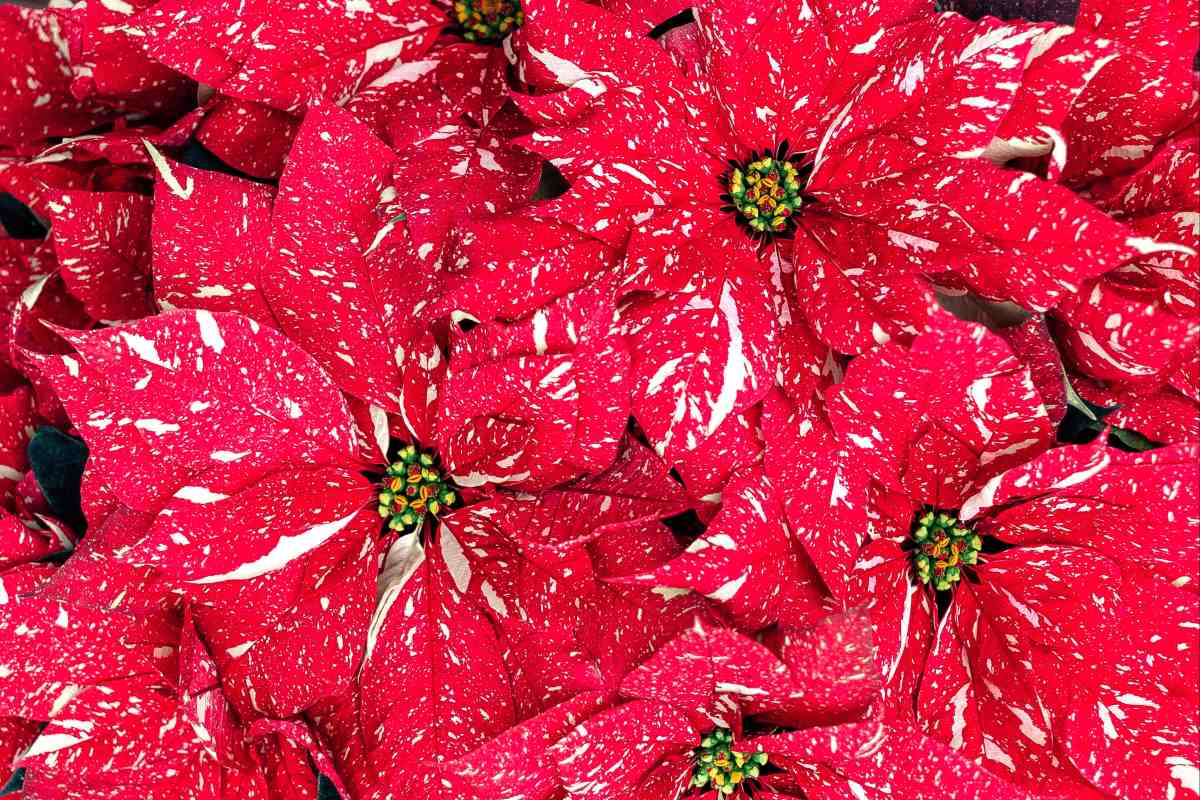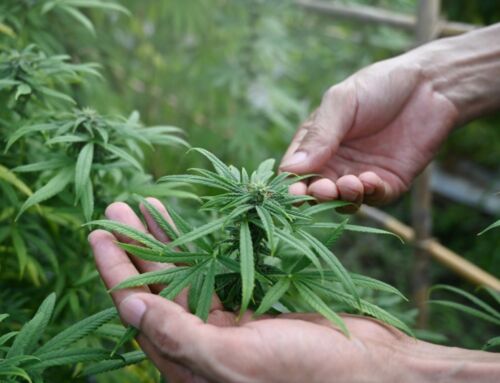Christmas is now less than a month away and with it, a staple holiday plant starts showing in most homes – the Poinsettia. No other plant carries such a cheerful holiday plant like the Christmas star, am I right?
Poinsettia, also known as Advent star or Christmas star, are perhaps one of the most popular and sought-after plants around the winter holiday season. And for a good reason: they come in a variety of colours that have a magical, festive vibe around them. They can be striking red, pink, white or one of my personal favourites – red with white splashes. When you look at them, these plants just have something incredibly cheerful about them and fit perfectly in the Christmas holiday festivities.
However, when it comes to caring for them, Poinsettia’s needs couldn’t be more different than what winter has to offer. These plants prefer bright light, moderate watering and don’t tolerate being exposed to cold at all.
Due to associating the Christmas star plants with well…, Christmas and the cold weather that comes along, a lot of people face a similar problem: their Poinsettia doesn’t make it long past Christmas.
With this article, we want to change that and help you navigate how to care for your Christmas star so that your Poinsettie can keep thriving throughout this holiday season and survive for many more Christmases to come.
How to Care for Poinsettia (Christmas Star)
Light
Poinsettias thrive in bright, indirect sunlight. Place them near a sunny window but out of direct light, which can scorch the leaves.
If you noticed that your Christmas star looks a bit stressed and there are discolored patches on the leaves that have a dry texture to them – it could be a sign that the light was too strong for your Poinsettia. In this case, moving the plant a bit away from the window or using a light diffuser would help you avoid your Christmas star’s leaves getting scorched in the future.
Reading tip: Easy Light Guide for Houseplants
Watering
Poinsettia originate from the tropical rainforests but they hate having wet feet and can quickly develop rot-related issues. On the other hand, you shouldn’t let your plant dry out completely between watering as Poinsettia tend to show signs of underwatering, such as droopy leaves and crispy edges, quite fast. And if you want your Christmas star to shine around the festive season, you want to keep your plant happy.
Therefore, to keep your Christmas star plant happy and healthy, only water the plant when the top inch of the soil (2-4cm) are dry. Make sure that the pot you are using for your Poinsettia has a drainage hole – this is pivotal to prevent waterlogging and salts built-up which can damage the delicate root system of your Christmas star.
As a general rule, Poinsettia need to be watered about once weekly. However, how often to water your Christmas star would depend on a lot of environmental factors, so it is always best to check the moisture level of the soil first.
Potting Mix
Your Christmas star will feel its best if planted in an airy but moisture-retaining potting mix. Most commercial potting mixes would work well but avoid a mix that is too heavy and compact. If the potting soil you currently have has no added elements of aeration, a handful of perlite for every liter of potting soil would work well.

Fertilizing
Your Christmas star is not too picky when it comes to what fertilizer you choose for it – a general purpose one would work. However, these plants are prone to suffering from fertilization burns so my advice would be to always start with a low dose and built up gradually from there.
For example, start fertilizing your Poinsettia only with 1/4 of the recommended fertilizer dose.
You would only need to feed your Christmas star occasionally during the growing season. Poinsettia tend to go dormant right after blooming (in winter), so during this time, it would be best to let the plant rest and not provide it with extra nutrients. This also means that while your Christmas star is actively flowering – you don’t need to feed it.
During the growing season, if you are using slow release fertilizer – apply it as directed around the base of the plant and then water. If you are using a liquid fertilizer, start with a very diluted dose and apply it biweekly. You can increase the dose gradually once you see that your Christmas star is feeling good, growing vigorously and thriving.
Important: If your Poinsettia is not feeling well, do NOT fertilize it! Sick plants should not be fertilized as this can quickly damage their already stressed root system and cause more problems.
Humidity
Most commercially sold Poinsettia plants have been acclimatized well enough and should not have problems with normal room humidity. However, if you really want your Christmas star to thrive, keeping the humidity around the plant in the middle range would be best.
Poinsettia would grow best when the humidity is between 40 and 60 percent. If you see that your Christmas star is looking a bit droopy, this could be a sign of low humidity, which is especially problematic during winter due to the use of heaters.
To increase the humidity around your plant, consider a humidifier or a simple pebble tray. Avoid misting the leaves of your Poinsettia as this could lead to fungal issues.
Temperature
As I mentioned already, Poinsettia are tropical plants and absolutely do not tolerate cold. This means that no, contrary to their name, Christmas star, these plants are not frost-resistant and you should not leave them outside if the temperatures are below 10°C (50°F) in the night.
Your Poinsettia would best grow if kept at temperatures between 18-24 °C (65-75 °F). Avoid placing these plants in areas with drafts, extreme heat, or cold, such as near open doors, windows, or fireplaces.
Pruning
Pruning is an essential part of Poinsettia care. The Christmas star plants grow in a bush-like form, so it is easy to shape them to your liking.
The best time to prune your Poinsettia is when the plant starts going dormant or at the beginning of the growing season, i.e. in early spring. It is best to avoid pruning the plant while it is blooming or when it is actively dormant as this can cause unnecessary stress and affect its health negatively.
Propagation

Even though Poinsettia tend to bloom yearly, the easiest and most convenient way is to propagate them through stem cuttings. It is fairly simple to propagate your Christmas star, especially if you do it when the season is right, in spring or summer.
Simply take a large enough cutting from your Poinsettia that has at least 3-4 leaves and while using a disinfected cutting tool, remove that part from the mother plant. Next on, remove the lower leaves, dip the stem in rooting hormone and either let it root in water first, or plant it directly in a loose potting mix.
Poinsettia cuttings usually take about 4 to 6 weeks to form roots and then a couple of weeks more to establish themselves as young plants.
Post-Holiday Care for the Christmas Star
In other words: How to keep your Poinsettia alive after the holidays.
What happens after the blooms start withering is that your Christmas star will go dormant as it needs some period to rest. What people do wrong here is that they assume that a) their Poinsettia is gone for good or b) it is best to keep it in the cold like other dormant plants during the winter.
After your Christmas star is done flowering, it will slowly and gradually start going dormant. This means that the leaves will fall, and you will not be seeing any new growth until the next growing season. This dormancy starts right around the time when the Christmas holidays end.
Once you notice that your Christmas star is not looking so festive anymore, it is time to let the plant rest. You can do some light pruning if you want but refrain from using fertilizer on the plant and water sparingly, about once every 3-4 weeks. Usually, it is best to water your Poinsettia during the dormant stage once you notice that the stem looks a bit dry, or wrinkled.
You will be happy that you didn’t dispose of your Christmas star once the new growing seasons start as usually around spring time, Poinsettia tend to break their dormancy and start growing again. At this point, you can go back to fertilizing the plant, pruning it or even propagating it once it has enough leaves and new growth.
Poinsettia Care: FAQ
Are Poinsettia toxic?
Poinsettias are often rumored to be highly toxic, but this is largely a myth. However, their sap can irritate the skin, and they can be mildly toxic if ingested, so it’s wise to keep them away from pets and small children.
How to encourage blooming?
Poinsettias are photoperiodic plants, meaning their bloom cycle is triggered by shorter daylight hours. Starting in October, provide 14 hours of complete darkness each day (e.g., by placing it in a closet or covering it with a box) followed by 10 hours of bright daylight. This regimen should continue for 8-10 weeks.
How to encourage colorful leaves?
Poinsettias are “short-day” plants, meaning they begin their color change as the days get shorter and nights get longer. This usually starts in the fall as the natural daylight decreases. For the bracts to change color, poinsettias need about 14 hours of continuous darkness each night for at least 6-8 weeks. Even a small amount of light during this period can prevent them from turning color.


